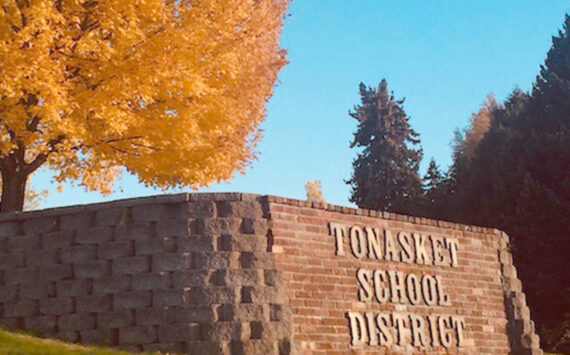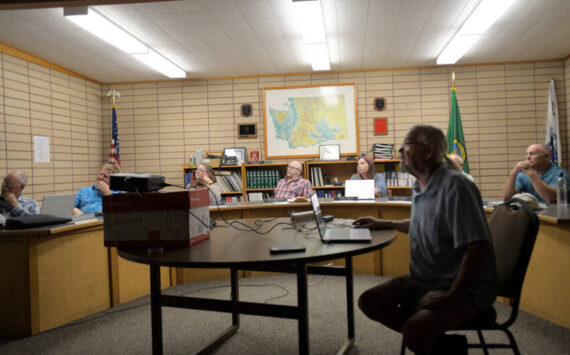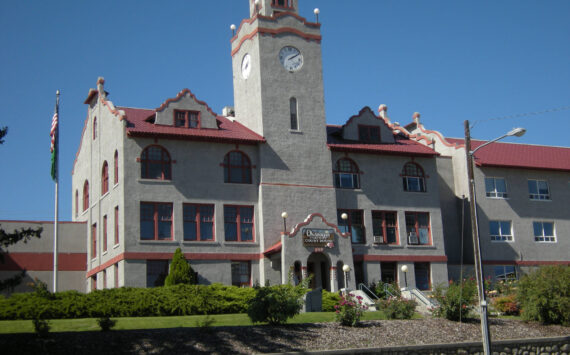TONASKET – Tonasket School District administrators reported at the Nov. 28 school board meeting about the district’s progress toward meeting state-mandated proficiency levels that must be achieved by the 2013-2014 school year.
Superintendent Paul Turner, high school principal Jeff Hardesty, middle school principal Jay Tyus and elementary school principal Jeff Cravy, as well as special education director Liz Stucker, discussed AYP (Annual Yearly Progress) numbers, achievement level statistics and the methods being used to improve the schools’ performance.
The AYP summary indicates in yes/no format whether each school meets goals both in testing proficiency and participation. The elementary school (data for grades 3-5 only) did not meet the proficiency goal in math or reading, but did meet participation goals in both. The middle school met the proficiency goal in math, but not reading, and met the participation goals in both. The high school met proficiency goals in both reading and math, but did not meet the participation goal in reading thanks to a number of unexcused absences.
The proficiency standard indicates whether or not students met or exceeded target levels for their grades; the participation standard requires that 95 percent of the students enrolled in each grade took the test.
There is far more detailed data for administrators to sift through and determine if the schools are progressing to their goals, indicating not only whether students are proficient or not proficient, but how many exceed the standard, meet the standard, are “at risk,” or are below the standard.
Much of the discussion focused on trends in the data, such as shrinking the number of students scoring at levels that required intervention.
Cravy noted that while there is more work to be done on the math end of things than in reading, the data being gathered through assessments is providing the teachers with specific direction.
“With the new math assessments we are doing … the MBA (Math Benchmark Assessment) data tell us: this is what I’m teaching right now, we just did an assessment on it, I just got the test results back, and I know what to do tomorrow,” Cravy said. “Because last week this is what we taught, and this is where the students are at, and this is what we need to do. So (the teachers) are using that information to really drill down.”
PLCs (Planned Learning Communities) have been one tool used for the teachers to focus their efforts. PLCs involve a process where teachers and administrators work together to analyze and enhance their effectiveness as instructors for the students’ benefit.
“The teachers work on focusing on the data and changing their instruction where needed,” Cravy said.
The PLCs focus on four basic questions: What do we want the students to learn? How will we know if the students are learning? What will we do if the students are not learning? And what will we do when they have learned it?
Tyus said one of his main goals at the middle school is to get his kids ready to move on to the next level.
“We don’t care where they’re coming from, we don’t care where they’re at,” Tyus said. “We care that we finish and get them ‘high school ready’ right here. They are our children; send them, bring them to us, let’s work on solving problems.”
While the middle school’s AYP showed it had met the math proficiency goal for this year, Tyus said that overall the reading scores were more promising.
“Reading looks a little better than our math, which is a little funny because we made our math goal and didn’t make our reading goal,” he said. “Different tests measure different things. But you can see there is a tremendous amount of work to do.
“We have an obligation to the high school to (reduce the number of kids requiring intervention). That’s our obligation to the system of schools that we work in.”
He said that to that end, his teachers are working to embrace the Marzano method of implementing standards-based education.
“We finally came to an agreement that we wanted to practice what the Marzano model of instruction looks like, so if it is in fact what we use for the teacher evaluation, that we are comfortable and we have practiced for two years on what we have to be measured on. I think it’s a great statement on the professional character of our teachers. Not only do they not want to have surprises, but they want to be really good at what they’re accomplishing.”
Hardesty said at the high school, he wants the focus to be able to be on career exploration. And having kids come up from the middle school having met those benchmarks is important to their being able to continue their development.”
“If (the middle school) can help get the ninth grade down to here (and minimize the number of kids not meeting the standards), and ‘right the pyramid,’ that allows us to do what we’re responsible for doing,” Hardesty said. “Which is career exploration, so when kids get to 12th grade, they are ready to go on and do whatever they want. So the question is, how do we right this pyramid? (In other words) how do we not only address (the advanced) kids but also these (not as proficient) kids as well?
“It’s about sustainability, it’s about a system, it’s about a bicycle that is well-oiled. Every system has to be employed and embedded in the culture.”
The tools in place, Hardesty said, should enable the teachers to continue to find new ways to prepare their students for whatever career they choose. The PLCs also are a major factor at the high school level, though Hardesty said they bear little resemblance to what is occurring at the elementary level since the requirements of students and teachers are so different.
“I’m pretty excited about the direction we’re headed,” Tyus said at the conclusion of his presentation. “We’re far from perfect … but I start looking at schools that are off-the-charts great, and they have a system where all the schools outperform everybody. So we’re working to become a system that outperforms everybody.”




